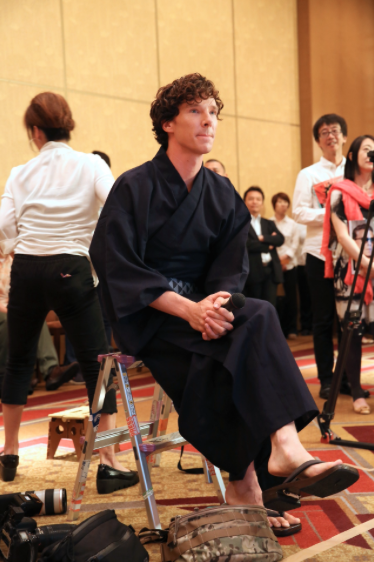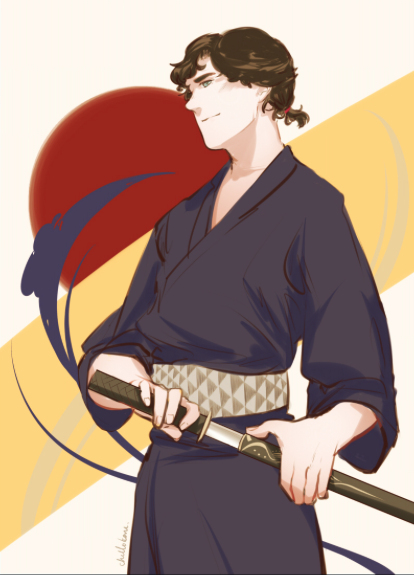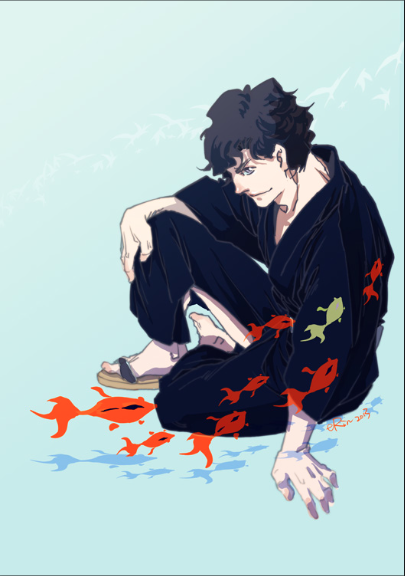In December 2012, Benedict Cumberbatch arrived in Japan from the UK several hours after filmmaker J.J. Abrams and actor Chris Pine had arrived from Los Angeles to take part in a preliminary press junket for the summer 2013 release of Star Trek Into Darkness. Apparently unbeknownst to Cumberbatch, as well as to a Japanese mass media always on the lookout for the next big thing, roughly 500 fans – overwhelmingly female – were waiting for him on his arrival at Tokyo’s Narita International Airport, the information about his flight number and arrival funneled through Sherlock and Cumberbatch-related websites that had, in turn, received it from Paramount Japan. Where Chris Pine had garnered some fleeting recognition from the many fans who had already begun gathering earlier in the day to see Cumberbatch, Cumberbatch himself received an enthusiastic welcome and attempted to respond in kind, shaking hands and acknowledging as many of his fans as possible as he was ushered to the door.
This outpouring of interest in the heretofore all-but-unknown Cumberbatch generated considerable attention within the Japanese mass media. Prior to his arrival in Japan, Cumberbatch had only been featured in one Japanese publication, Hayakawa Mystery, in a special issue focusing on BBC’s Sherlock in preparation for a New Year’s broadcast of series 2. However, the enthusiastic turnout at the airport caught the attention of magazine editors who were then faced with slowly declining interest in, and not insignificant backlash against, South Korean stars and shows – the fandom of which had sustained them for nearly a decade. In Cumberbatch they had a non-Asian star – one of the only outside a Hollywood context to generate this degree of popularity in nearly twenty years – who brought with him that nation-based pedigree that has been a constant of foreign star promotion since at least the late 1980s and the first ‘heritage film’-fuelled British star boom. Soon, magazine articles based on the interviews Cumberbatch conducted during his visit proliferated in the Japanese press, each proclaiming him a quintessential ‘English gentleman’ and, in turn, helping to spur what would, by the latter half of 2013, become a full-blown British male star boom.
By the time of Cumberbatch’s second Japanese junket, conducted a month before the Japanese August premiere of Star Trek Into Darkness, he had become a full-fledged phenomenon, less on the basis of his anticipated role in the reboot of an American TV show that, in Japan, had little more than niche popularity, than on his starring turn in BBC’s Sherlock, which had only begun airing in Japan in late 2011, and then in a late-night slot on national broadcaster NHK’s premium satellite channel. Which is to say, Cumberbatch’s Japanese fandom was itself quite niche, but it was also part of a broader global fandom that enjoyed momentum primarily online, and it was for this reason that on this second trip, spearheaded by the careful dissemination of information by Paramount Japan, Cumberbatch was greeted by 1000 fans. The degree of ‘fan service’ he provided at the airport, which after his December junket had been favorably compared to that of such fan service luminaries as Johnny Depp and Leonardo DiCaprio, was scaled back somewhat; however, he did take the time to stop and talk to the gathered crowd, satisfying even those who had been waiting in place since as early as 3 am that morning.
Moreover, in anticipation of broad interest in Cumberbatch’s visit to Japan, his arrival was streamed live online on a feed available not only to Japanese fans unable to be at the airport, but to overseas fans as well. Indeed, the entire junket played out online in real time over the course of the next four days, ultimately giving global fans insight into the ways that celebrity fandom plays out in Japan and influencing fannish activity spurred by the visit in ways that reveal the increased porousness – both cultural and fannish – of transcultural fandom in the age of social media.
Although a long, highly stylized press conference that was streamed online was a key feature of Cumberbatch’s promotional activities (supposedly geo-locked outside of Japan, although the video on the NicoNico video hosting site was, in fact, viewable abroad), for many fans the penultimate event came in the form of a much smaller-scale gathering on July 18 to mark Cumberbatch’s crowning as the 2013 “King of Magazines.” Unannounced ahead of time, photographs of this event were made public during the overnight hours in Japan, featuring Cumberbatch wearing a Japanese summer kimono, or yukata, accepting a plaque with the covers of issues of Screen magazine in which he had been featured from the editor of Screen himself
and posing with an even wider variety of (largely female) magazine editors whose publications also had featured Cumberbatch over the course of the previous seven months.
More than these individual photo opportunities, however, it was the fact of Benedict in a yukata
that seemed to capture fans’ imaginations globally.
In fact, the yukata-clad foreign star is something of a trope within Japanese promotion of non-Japanese celebrities. Although major Hollywood stars are often exempted from this particular rite of passage, historically, the younger and/or less Hollywood a star, the more likely she, and more recently he, is to be photographed wearing a yukata. In the 1980s, it was young idol-esque stars such as Phoebe Cates and Sophie Marceau who graced the covers and pages of Screen and Roadshow magazines in yukata;
during the 1990s Hong Kong star boom, starlets such as Vivian Su replaced the Western women of the previous decade (although not completely supplanting them among Japanese fans), and it was during this period that we began to see non-Japanese men such as Leslie Cheung – popular amongst a passionate group of female fans – also photographed in (formal) yukata.
In one sense, such photographs of non-Japanese stars wearing traditional Japanese yukata were something of a gift to both the star, here given a singular, if fleeting, opportunity to step into ‘traditional’ Japan, and Japanese fans who were afforded through them a degree of cultural proximity to stars, however symbolic. Yet, such photographs also served two ulterior, if not necessarily intentional, purposes: first, and especially in the case of Western stars, they constituted a kind of auto-exoticism in which what was ‘traditionally’ Japanese, and thus ordinary, was made new and interesting through its grafting onto a visibly non-Japanese body; second, they foregrounded the fundamental difference of the foreign star through their visual incongruity. Particularly in the case of Western stars (insofar as East Asian star bodies are subjected to a different, and often more fraught, politics), the juxtaposition of physical Westernness and the ‘Japaneseness’ of the yukata paradoxically distanced them from cultural belonging rather than enfolding them within it. Which is to say, dressed in yukata, such stars become subjected to a specifically Japanese national gaze; one that, in exoticizing them, sets them apart from the main of Japanese popular culture. The yukata then is a signifier of Japaneseness, for a discrete definition of ‘Japanese’; it belongs wholly to ‘Japan’, and is something that the foreign star can take with them when they – critically – leave the country.
This was presumably the context within which Cumberbatch was outfitted in yukata for the King of Magazines event. However, within hours of photographs of the event being posted online, they had not only circulated globally on such social media networks as Twitter, Tumblr, and the Chinese social media site, Weibo, but they were the catalyst for fan art that was being produced within hours of the photographs going live. Some of this art came from what we might call the usual suspects: well-known fan artists who quickly turn notable photo opportunities into stylistically idiosyncratic works. Indeed, one particularly prolific American fan was one of the first to post artwork based on the event, in which she dubbed him YukataBatch, a name that became the most common tag on Tumblr for photographs and art to come from the event. This was shortly followed by art from fans in Taiwan and China, each of which reflected the artist’s own aesthetic and, in some cases, even a cultural style signified by the use of Chinese brush painting techniques. Such art was done very much in the style of the individual artist, whose other fanworks evinced a similar aesthetic, and they constituted a clear, if wholly anticipated, transformative response to the stimulus of the unusual Cumberbatch photographs.
At the same time, in much of the art that proliferated in the hours and days following the event, we find a distinct, and substantially more uniform, style emerging; that of Japanese anime and manga. In art drawn by fans from Hong Kong,
China,
Thailand, and elsewhere outside of Japan, facial features, clothing, and bodies reflected a broad anime/manga aesthetic that we might be tempted to interpret as a stylistic homage to the Japanese trappings of the event and the Japanese junket as a whole. In fact, such styles were as specific to these individual artists as those of the preceding ones, their yukata!Batch art equally consistent with their own body of work.
Furthermore, during the NicoNico press conference that was streamed online, Cumberbatch himself anticipated the specific turn of a subset of fan artwork in a rueful response to a message from one fan (at 51:42).
This press junket took place during a hiatus in the filming of series three of Sherlock, while Martin Freeman was in New Zealand to do pickups on The Desolation of Smaug leading up to its December 2013 release. To that point, two of three episodes of Sherlock had already been filmed, with work on the third and final episode remaining. After making a detour through New Zealand for his own follow-up work on The Hobbit, Cumberbatch flew to Japan for the Star Trek Into Darkness junket, his ‘Sherlock hair’ intact in all its unkempt curliness – a look to which Cumberbatch is famously averse.
Whether a concession to the excessive heat and humidity of Tokyo in mid-July, or to his Paramount Japan handlers (or possibly both), for the Japanese junket Cumberbatch sported the full Sherlock throughout his stay, with the effect that, in yukata, he looked like nothing so much as his own iteration of Sherlock Holmes in yukata – an image that, in fact, had been imagined by Japanese fans posting art on Pixiv and Tumblr from at least as early as 2012, predating Cumberbatch’s Japan junket.
With the appearance of the yukata!Batch photographs, fans of both Cumberbatch and BBC’s Sherlock – a combination that, while natural enough, is not always a foregone conclusion – produced art that bridged both, in which yukata!Batch was made Sherlockian either by the inclusion of a specific reference to Sherlock, or – more typically – by the additional, and occasionally eroticized, presence of John Watson.
Here, too, we often see an anime aesthetic at work in the depiction of these two quintessentially British characters, signifying a far more heteroglossic, hybrid reflection of fan interests than can be accounted for in a unidirectional, nation-based model of transcultural fandom.
Indeed, even where the anime aesthetic is absent, we still find the lingering influence of Japanese anime in yet other yukata!Batch-inspired Sherlock fan art. In several pieces that emerged within the first 36 hours after photographs of the event began circulating online, we find not an anime visual style, but rather a narrative/visual trope specific to Japanese anime and manga brought into play. I asked students in the anime class I taught last autumn what it was that visually signifies ‘summer’ in Japanese anime and manga, and to a one they immediately responded “summer festivals” – natsu matsuri. Indeed, scenes of summer festivals are so standard in Japanese anime and manga as to have their own iconography; thus do we find in an advertisement for a summer festival centered on the anime Servant x Service, an uchiwa, or flat, paddle-style fan, a clear plastic bag containing a goldfish, won in a game that involves dipping a rice-papered paddle into water to catch a fish before the paper disintegrates, animal/character mask, cotton candy, and as in all summer festival-themed anime and manga, we have the ubiquitous uniform of the summer festival, yukata.
All of which make appearances in Japanese Sherlock-centered artwork produced prior to Cumberbatch’s July junket, in which both John and Sherlock wear yukata and sport fans and shaved ice, another iconic festival treat.
Non-Japanese art that was produced immediately after the first yukata!Batch photographs first came online also reflected familiarity with these summer festival tropes; here, however, this familiarity was born not of Japanese belonging – lifelong immersion in a Japanese cultural context – but of the absorption of the imagery of summer festivals, as deployed in Japanese anime, into non-Japanese fans’ own popular cultural repertoires. Thus do we find Chinese artwork reflecting both an anime aesthetic and such festival tropes as masks, goldfish, fans, and food, a French fanwork that shares this iconography, adding to it a cell phone decorated with the dangling decorations favored by young Japanese women and drawn in a hybrid anime/manga and vaguely Tintin-esque style, and art by another Chinese fan in which we find both goldfish and fireworks.
Which is to say, we see in yukata!Batch-centered fan art the quick and clear emergence of an aesthetic reflecting an ostensible ‘Japanese’ origin – both thematic and aesthetic – that was, in fact, less about its Japaneseness than about these fan artists’ own anime/manga-inclusive popular cultural repertoires. It should be noted that these fan artists typically do not draw non-Japanese characters or people in Japanese clothing or settings; that is, here, it was the catalyst of Cumberbatch in a yukata that spurred them to use their (apparently) Japan-centered style in the service of Japan-themed art, rather than being a ‘natural’ extension of that style’s inherent ‘Japaneseness’.
In a broad sense, what we see in such fanworks is the extent to which anime/manga style and themes have become unmoored from their Japanese origins, and this at a time when the Japanese government is heavily invested in promoting anime and manga abroad as a means of creating so-called “Japan fans” under the aegis of Cool Japan policies. This, in turn, reflects the increasingly porous nature of both the nation as a producer of popular cultural content, as well as of fandom itself. In the same way we speak of ‘Japanese’ or ‘British’ or ‘American’ fans as definable by geography and cultural context, we also speak of ‘anime fans’, ‘Star Trek fans’, ‘Benedict Cumberbatch fans’ as if they, too, are definable by that one object of their fannish interest. This is only reinforced when the two meet – when fandoms cross borders, resulting in Japanese fans of Korean stars, American fans of Japanese anime, British fans of Danish cult television, and so on. Yet, a focus on stars who, outside the more conservative Hollywood context, are themselves often both generically and industrially porous, working in comedy, drama, high and low cultural forms, across radio, television, theater, and film, reflects the extent to which this kind of discrete categorization is antithetical to the ways that transcultural fandoms arise and are pursued.
In this sense, especially given the historical role of the foreign star yukata photo op in reinforcing difference and clear-cut divisions of national (and Japanese fannish) belonging – however unintentionally – as well as the contemporary conscription of anime in the branding of Japan, it is ironic that these fanworks in fact embody the multiple, and sometimes disparate popular cultural contexts of individual fans who are themselves inextricably enmeshed in an increasingly transcultural playing field, whose interests today are driven not simply by the national origin of stars, texts, or mediums, but by the affective affinities that fans of a diversity of media discern in each.
——————————–
Art by Chellokuro, 403Shiomi, and Erinpaint used with the artists’ kind permission
Originally presented at the Southwest Popular/American Culture Association Conference, 22 February, 2014











Pingback: The Year in Productivity | some of us are looking at the stars
Pingback: Yukata!Batch Goes Global | On/Off Screen - Unjapanologist/非実在日本学者